1 Introduction
Individuals often categorize themselves based on their group affiliations and tend to perceive people within and outside their group differently. Since the work of Sherif (1961) and Tajfel et al. (1979), studies have documented instances of in-group favoritism and out-group bias. For example, people are more generous and trustful toward fellow group members. This is in contrast to a “universalist” perspective, whereby there is no differential attitude based on group belonging (Enke et al., 2022). On the one hand, parochialism may foster cohesion within a community. On the other hand, in an increasingly interconnected and diverse world, parochialism might hinder collaboration between different groups, potentially limiting opportunities for mutual benefit.
Nationality is one such trait that often defines groups and may lead to prejudice toward non-natives (Choi et al., 2022; Kustov, 2021). Existing studies have mainly examined attitudes toward an indistinct out-group, irrespective of the specific features that the members may have. More recent evidence, however, based on hypothetical scenario experiments, shows that locals display a preference for migrants or refugees of certain origins, skill levels, or skin tones rather than others (Hainmueller and Hopkins, 2015; Bansak et al., 2016, 2023; Bursztyn et al., 2024). Shayo (2009), Shayo (2020), Fouka et al. (2022) and Fouka and Tabellini (2022) conceptualize the role of “distance” in how natives rank different minority out-groups.
In this paper, we present findings from an online survey experiment that we conducted to study the impact of perceived distance on attitudes toward different out-groups, with a focus on refugees. Specifically, we assess the presence of differential support toward refugees from Ukraine and from war-torn African countries. We also investigate whether EU-wide refugee and immigration policies can shape these attitudes.
The Russian invasion of Ukraine in February 2022, and the subsequent refugee crisis, offer a testing ground for analyzing group-based preferences. Refugees are forced to leave their home countries because of persecution or other conflict-related reasons. As such, one may expect that there should be no or only limited aversion toward this particular outgroup. In reality, the public perception of refugees remains mostly negative (Bansak et al., 2016; Hangartner et al., 2019). The response of host countries to the arrival of refugees from Ukraine, however, has been markedly different. The media reported quotes by politicians and the public describing them as “people like us,” with “blond hair and blue eyes,” “the sorts of people who can contribute,” “not like those from Afghanistan,” “they are white,” to name a few examples (Overseas Development Institute (2022)). These quotes suggest a disparity in how citizens and policymakers may have treated Ukrainians compared to other refugees, such as those from Africa or the Middle East. The difference could derive from Europeans’ empathy for Ukrainians as well as from a process of “othering” (Abdelaaty, 2021) of African refugees, because of their greater ethnic, religious, and cultural distance. This perceived distance may influence the willingness to welcome migrants and the expectations about the effects of immigration (Tabellini, 2020). However, whether these are just anecdotes or indications of systematic attitudes is an open question.
Additionally, following the Russian invasion, the twenty-seven states of the European Union (EU) agreed for the first time to implement an EU-wide refugee-reception plan based on relocation quotas between the various EU members.1Specifically, for the first time in March 2022, the member states activated the Temporary Protection Directive 2001/55/EC that promotes an equal balance of effort in hosting asylum seekers in case of a “mass influx” of displaced persons. This reform may influence attitudes toward refugees in several ways. First, a more decisive EU role in enforcing asylum and border policies may increase trust in European institutions and their immigration policies. A second effect may be in the opposite direction: the EU may be perceived as becoming too open and welcoming toward migrants, leading to more negative attitudes. Although there is evidence that policies reflect public opinion (Burstein, 2003), studies on whether attitudes respond to policies are scarce (Vrânceanu and Lachat, 2021). Moreover, there is growing scholarly interest in the effects of priming various types of interventions on attitudes toward immigrants (Dylong et al., 2023; Alesina et al., 2023), or priming a European identity as a common project versus a common heritage on cooperative attitudes (La Barbera et al., 2014), but attempts to analyze the effect of a migration policy reform by a supranational entity, such as the EU, on natives’ attitudes are limited.2An exception is Solodoch (2021).
Understanding whether preferences and behaviors towards out-groups are hierarchical, based on certain characteristics such as perceived distance, could help identify policies that may enhance inclusion and reduce prejudice. Furthermore, the coordinated management of migratory processes and refugee crises might have the additional effect of changing attitudes toward populations of less familiar origins if policies had this ability to affect social norms and beliefs. Interventions at the supranational levels may also preempt detrimental unilateral actions by individual member states in the EU.
The participants in our survey were 4,087 Italian residents, representative of the Italian adult population. We selected Italy because of its high exposure to migration flows, particularly from regions such as Africa and the Middle East. Being a prominent port of entry, especially for boats carrying migrants and refugees, Italy has faced challenges in managing this phenomenon. More recently, with the Russian invasion of Ukraine, refugees started crossing the borders with adjacent countries and were relocated throughout Europe, including Italy.
We gave survey respondents the opportunity to make a donation to groups of beneficiaries that varied by nationality to test if natives display differing attitudes toward different outgroups.3Enke et al. (2023) study universalism in donation where distance (or “in-groupness”) is at the district level within the United States. Italian victims of violence were the in-group of reference. The two treatment outgroups were refugees fleeing the war in Ukraine and countries in Africa experiencing conflict. These two groups clearly differed in their “distances” (e.g., ethnic, religious, cultural) from the survey participants, who were all Italian nationals. Moreover, to test the effect of a stronger role of the EU on the respondents’ attitudes toward refugees, we provided information about the EU’s recent initiative for a more active role in refugee management, including the activation of the Temporary Protection Directive and relocation quotas, hinting at its potential as a standard EU policy.
To assess attitudes, we relied on an established measure of incentive-compatible behavior and also introduced a novel measure that, we argue, is less likely to be affected by social desirability bias and thus can measure prejudice more accurately. Specifically, we gave survey respondents a one-euro endowment and offered them the opportunity to donate part of it to support a certain group of individuals in need. In addition to this standard donation choice, we asked those who chose to donate to determine the composition of their donation between cash and in-kind support.
Donations made through an intermediary organization which then provides beneficiaries with in-kind support are commonly used to measure attitudes (Fong and Luttmer, 2009; Grigorieff et al., 2020). However, in the context of an experiment, the amount that one chooses to donate might be influenced by concerns about one’s social image, such as wanting to appear compassionate to the experimenter, thereby not truly reflecting attitudes. Although the act of donating may be subject to social pressures, the more nuanced choice between cash and in-kind gifts might be perceived as less salient and thus less prone to such influences. Evidence shows that people in need prefer to receive aid in cash (Liscow and Pershing, 2022), but donors typically would rather contribute in kind, reflecting their perceptions about the recipients’ responsibility, agency, self-control, or potential misuse of funds (Halapuu et al., 2013). Especially when donating to groups toward which there may be only limited trust, hesitancy to give cash could subtly reveal underlying prejudice.4That poor people make bad use of cash is a long-standing, widespread prejudice (Evans and Popova, 2014). Moore (2009) reports a senior government official in Nicaragua saying, while discussing a cash transfer program, that “husbands were waiting for wives to return in order to take the money and spend it on alcohol.” Statements like this are variants of the so-called “big TV theory,” from the phrase “Rich people have small TVs and big libraries, and poor people have small libraries and big TVs.” (Taylor, 2022). Lower-income individuals are also held to more restrictive standards and judged negatively for purchasing the same items as their higher-income peers (Hagerty and Barasz, 2020). Although donors are likely aware that the amount they decide to give can be easily interpreted as a measure of their attitudes and generosity, they may make their prejudice or differential trust emerge in a more subtle and less apparent fashion via the proportion of their donation that they elect to give in cash.
When we consider the overall amount donated, we find a generalized out-group penalty; participants are more generous toward Italian recipients than toward Ukrainians and Africans, with no differences between the two groups of refugees. In contrast, evidence of differential out-group prejudice emerges from the decision about the in-cash share of donations; this share is significantly lower for African recipients than for Ukrainians, suggesting a ranking of preferences between different out-groups based on their distance from the in-group.
Informing about a stronger role of the EU does not influence either of the two measures of attitudes. This null effect does not derive from inattention to the provided information, as we find that this information does influence the expectations about the number of refugees arriving in Italy. Rather, the information does not affect two possible channels the existing literature suggested as linking policies and attitudes: the respondents’ perceived trust toward European institutions and what is considered a socially appropriate donation level.
We then perform (preregistered) heterogeneity analyses, focusing on the respondents’ education, political orientation, and strength of European identity. When measured through overall donation levels, in-group preferences and out-group bias characterize almost exclusively individuals without a college degree, plausibly because of lower exposure to diverse perspectives and knowledge about global issues and a higher perception of immigrants as an economic threat. As for the share of cash donations, we find a similar ranking of preferences among both low- and high-education respondents. For left-leaning respondents, there is no difference in the willingness and extent of support for the three groups of recipients. In contrast, there is a differential out-group prejudice among individuals leaning toward the right end of the political spectrum, both in terms of overall donation and share donated in cash. The lower universalism of conservative individuals manifests itself not only with lower support to out-groups in general, as suggested by the literature (Waytz et al., 2019), but also through a clear hierarchy between out-groups, with Africans more penalized than Ukrainians. The strength of respondents’ identification with Europe does not differentially correlate with attitudes toward in-group and out-group members in need, and this result holds, irrespective of the measure of prejudice adopted.
We rely on additional analyses of responses to both close- and open-ended questions to better interpret how respondents perceived cash donations and to corroborate our hypothesis that the distance from the out-groups drives the hierarchy of preferences. Text analysis indicates that the choice of the type of donation is influenced by beliefs about the positive or negative use the recipients would make of the cash received. Participants who chose not to donate cash were more likely to predict purchases like alcohol, cigarettes, or drugs. In contrast, those who opted to donate at least some amount in cash expected more positive uses for the funds, such as buying food and clothing. These expectations correlate with (mis)trust toward the beneficiaries. In addition, participants who reported having right-leaning political views show greater mistrust or paternalism toward Africans, who are the more distant out-group. When donations target African recipients, not only right-leaning respondents are particularly concerned about the harmful use of cash donation, but left- and right-leaning respondents display the largest discrepancy in the expectation about good and bad use of cash. The underlying patterns of (mis)trust, especially toward more distant groups, indeed appear to be influenced by inherent biases or preconceived notions.
Additional tests allow us to rule out alternative explanations for our findings, such as the different salience of the war in Ukraine and the migratory processes from Africa during the study period, the potentially different perceptions of the needs of refugees according to their provenance, and the expected duration of refugees’ stay abroad from their home country.
In sum, our results provide evidence that out-group bias increases with perceived distance. These differential attitudes may be subtle and hard to detect: the more standard, incentive-compatible measure that we used did not show any difference according to the distance of the recipient group, which instead emerged with a measure that suffers less from social desirability bias. The additional finding that differential attitudes pertain mostly to respondents with right-leaning political views, together with previous evidence that conservatives have more particularistic preferences (Enke et al., 2022), suggests that parochialism may not only separate between in-groups and out-groups, but also “rank” out-groups according to perceived distance. Conversely, and perhaps also because of the ingrained nature of these beliefs, EUlevel reforms that would likely distribute migrants and refugees more effectively do not affect attitudes toward refugees. As such, interventions targeting deep-seated biases directly may be more effective in changing attitudes toward refugees than policy reforms that focus on the regulatory aspects of migration.
In the next section, we provide details on the survey design. Section 3 presents information on the collected data and describes our findings. Section 4 concludes with a discussion of the implications of our study.
2 Research design
Figure 1 displays the structure and flow of the survey experiment, which ran between November 30, 2022, and January 16, 2023. We collaborated with the market research and survey company Bilendi/Respondi to recruit respondents who were residents of Italy. The sample consisted of 4,087 individuals and was constructed to match the Italian population on sex, age, macro-region of residence, and education. The survey was conducted online and began with questions on the socio-demographic characteristics of the respondents, including gender, age, family status, education level, employment, and political orientation. We also gauged the participants’ sense of belonging to their town, Italy, Europe, or the “global society,” and measured their generalized trust in others by asking whether they agreed with the statement that people always act with the best intentions (Falk et al., 2023).
All participants had an endowment of one euro, and we offered the possibility to donate any share of it (including zero) to different target groups. The experimental manipulation consisted in randomly assigning the respondents to one of four treatments or a control condition. In the control condition, respondents could donate to Italian citizens who have been victims of violence and abuse or were otherwise vulnerable. The design of the four treatments had a two-by-two structure. The first feature that we varied was the origin of two groups of refugees: Ukraine (boxes U1 and U2 in Figure 1) and war-affected countries in Africa (boxes A1 and A2). Thus, the beneficiaries of the donation in the control group (box B) represent the baseline in-group against which we compare the respondents’ attitudes toward the two out-groups of Ukrainians (the less distant out-group) and Africans (the more distant out-group).
The second variation was in the provision of information about the possible enhancement of the European Union’s role in managing refugees. In one version (boxes U2 and A2 in Figure 1), we outlined a recent reform of the EU asylum regime, specifically intended to manage the influx of refugees fleeing Ukraine after the Russian invasion of 2022. For the first time, the Council of the EU activated the Temporary Protection Directive, which intends to balance efforts between the member states in receiving displaced persons.5The temporary protection is an exceptional measure intended to expedite the process of granting temporary protection in the event of a mass influx of displaced persons from non-EU countries. In particular, the directive sets up a scheme to deal with mass arrivals of asylum seekers in the European Union, puts in place immediate temporary protection for these displaced people, and promotes a balance of efforts between EU member states in hosting asylum seekers without imposing a compulsory distribution. Moreover, we mentioned the possibility that the directive might be extended to managing refugees (from entry to eventual relocation) more broadly, not just those from Ukraine. Conversely, the other version (boxes U1 and A1) did not reference this specific reform or the possible role of the EU in managing refugee inflows. The existing system, known as the Dublin Regulation, dates back to 1990 and assigns legal obligation and responsibility to process asylum seekers to the first country of arrival. However, given that most asylum seekers first arrive in the peripheral countries of the EU, the burden of managing the flows is not equally shared by the various member states. Despite evidence of public support throughout the EU for a proportional equality rule that allocates asylum seekers proportionately to each country’s capacity (Bansak et al., 2017), to date any attempt to broadly reform the system has failed. Suggesting a more significant EU role in enforcing asylum and border policies may affect attitudes toward refugees through three different channels. First, it may lead respondents to anticipate a potential shift, either upward or downward, depending on the country, in the influx of refugees. Second, it could influence trust in European institutions. Halapuu et al. (2013) document that trust and tolerance toward immigrants improve when people perceive political institutions as fair and supportive. The EU reform could also signal competence, security, and control over the management of the flows, which again could reduce hostility toward migrants (Solodoch, 2021). Third, the reform could affect what is perceived as normatively appropriate and thus legitimize certain opinions and behaviors, either toward conforming with the attitudes implied by the new policies (Sjöberg, 2004; Bursztyn et al., 2020), or in the opposite direction (Dennison and Kustov, 2023; Solodoch, 2021). Additionally, the impact of emphasizing the role of the EU could vary depending on the perceived social or cultural distance between the in-group and the out-groups.
After showing the text with the assigned experimental conditions, we assessed the respondents’ attitudes toward the beneficiaries with two measures related to the donation opportunity. First, we asked respondents whether they would be willing to donate part of their one-euro endowment through a charitable organization and, if so, how much they wished to donate.6At the moment of donating, we told respondents that the donation would be made through a certified charitable organization that operates on the Italian territory, without specifying the name of the organization. At the end of the survey, we revealed this organization to be the Italian Red Cross, which has programs to assist refugees as well as victims of domestic violence, either in the form of in-kind transfers or cash assistance. Second, we asked those who donated a positive sum what share of that amount they wanted the association to transfer to the beneficiaries in direct cash and how much as an in-kind gift, in the form of essential goods.
We employ these two measures to obtain a more nuanced understanding of attitudes. In particular, the two choices are likely to suffer from social desirability bias differently. In the presence of image concerns, people are more prone to engage in behaviors that they think are socially accepted. In our context, participants may feel compelled to donate a larger share of their endowment to look compassionate or supportive, regardless of their actual feelings toward refugees.7Raux (2023) shows, for example, that individuals act more generously toward out-group counterparts, or are more universalistic, in the presence of an out-group than in the presence of an in-group audience. However, the choice of what share of the donation to transfer directly in cash is arguably less likely to be affected by these tendencies. Standard economic reasoning suggests that cash transfers are superior to in-kind ones because of the higher freedom of choice they entail. In fact, low-income individuals, when asked about their preference, typically choose cash (Liscow and Pershing, 2022). Conversely, the general population (which is more likely to include potential givers) prefers in-kind transfers. This may occur because givers care about the recipients’ consumption of specific goods and do not appreciate the consumption of other goods (Browning, 1981), or do not think that the receiver can discern good from bad uses of cash (Ambuehl et al., 2021; Cunha, 2014; Currie and Gahvari, 2008; Liscow and Pershing, 2022; MacKay, 2019). For a given donation level, a respondent may opt to give more in-kind donations than cash because of their belief that refugees might misuse the cash, even in the absence of evidence that this is actually the case (Evans and Popova, 2017). The trust in the good use of cash transfers may also depend on the identity of the beneficiaries. Preferences may be more subtly reflected in how aid is given, not just in whether aid is given or not. Baker (2015), for example, finds that white Americans are more willing to aid Africans than East Europeans. This result is due not to the larger perceived need of the former but to “an underlying racial paternalism that sees them as lacking in human agency.”8Alternative ways to measure racial attitudes more implicitly include the widely used Implicit Association Test (Greenwald et al., 1998), or Fong and Luttmer (2009)’s question about subjective closeness to one’s racial or ethnic group, which the authors interpret as a measure of subjective racial identification.
Figure 1: Experimental design
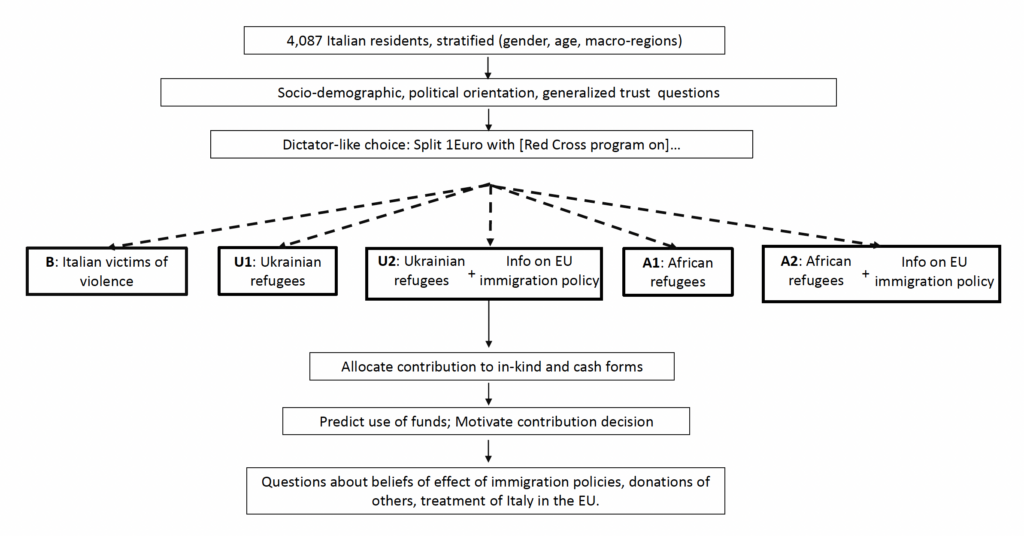
Notes: The figure shows the structure and flow of the survey experiment. The dashed arrow indicates random assignment, and the thicker text boxes contain the description of the five experimental conditions.
The survey then included two open-ended questions to provide us with additional information about recurrent motives, perceptions, and expectations regarding cash or in-kind donations and, more generally, insight into the respondents’ attitudes toward the population(s) of interest. The first question asked participants to predict how the recipients would spend the cash donation (or, for those respondents who did not make any donation or chose to donate only in-kind, how they believe the recipients would have spent it); the second question asked them to describe the reasons for their donation choices.
Finally, we asked respondents how much they expected the average donation of other respondents to be, and presented questions measuring their trust in the EU and their expectations of what a stronger role of the EU in asylum policies would imply for future volumes of refugees in Italy and Europe as a whole. As we discuss in detail below, these variables allow us to test possible channels through which the information on EU refugee policies could affect attitudes.
3 Data and Findings
3.1 The data
Panel (a) of table 1 presents summary statistics for the sociodemographic characteristics by which we stratified the sample and compares them to their distribution in the Italian population. Panel (b) provides similar information for other features of the respondents, including those that we preregistered for the analysis of heterogeneous effects: education, political orientation, and strength of European identity.
The share of college-educated respondents in the survey sample (15 percent) corresponds to that of the overall Italian population. To determine the respondents’ political orientation, we used a scale ranging from 0 (leftmost-leaning political orientation) to 10 (rightmost-leaning political orientation), in 0.1 increments. About 50 percent of the participants located themselves between 4 and 6.9, whereas the remaining half were at the two ends of the spectrum: 22 percent between 0 and 3.9, and 28 percent between 7 and 10. Finally, 55 percent of the respondents reported that they felt a sense of belonging to Europe “strongly” or “to some extent;” we classify these participants as displaying high European identity. The remaining 45 percent stated that they felt “little” or “no” sense of belonging to Europe. All of these characteristics of the respondents are balanced across the different treatments (appendix figure A.1).
Appendix table A.1 provides the percentage of respondents by donation choice. About 37 percent of participants () decided not to share their one-euro endowment, 26 percent (
) donated a positive amount but restricted their donation to be only inkind, and 36 percent (
) allocated some part of the donation in cash; of this last group, about 6 percent (
) decided to make their entire donation in cash.
3.2 Findings
3.2.1 Main results
Table 2 shows the ordinary least square regression estimates from the following equation:
(1)
where is either the total donation that respondent
makes or the share of the donation that the respondent donates in cash. The parameters
,…,
represent the differences in the outcome variable between each of the four treatment conditions and the control.
is a vector of individual characteristics of the respondents. To offset the potential for false positives that may arise from estimating the effect of multiple treatments on multiple outcome variables and multiple subgroups, we compute the sharpened false discovery rate (FDR) adjusted q-values (Benjamini et al., 2006).
Columns 1 and 2 report results from models where the outcome variable is the donation (measured in cents) that each participant made to their assigned target group. The estimates indicate a statistically significant lower donation across all four treatment conditions compared to the reference case. The difference is approximately 7 to 9 cents, the equivalent of 15 to 19 percent of the average donation amount (about 48 cents) made to the in-group.
The bottom of the table shows p-values from tests of differences across conditions based on the recipients’ nationality and whether the scenario mentioned reforms that would enhance the EU’s involvement in refugee management. These latter differences are small and statistically insignificant. In column 2, the estimates are from a specification where we combined the treatment indicators based on the nationality of the refugees, irrespective of the provision of information on EU refugee policy reforms. We confirm the presence of a general out-group bias, with no differences between the two out-groups.
For the estimates in columns 3 through 5, the outcome variable is the percentage of donations (if any) that participants elected to be given to refugees in cash. The results in columns 3 and 4 are from the subsample of participants who donated a positive sum, whereas those in column 5 are from the full sample, where we assign a percent of cash equal to zero to those who did not donate at all, and include a binary indicator for positive donation as a control. We find an out-group bias but only toward African refugees; there is no statistically significant difference between the percentage of cash donations to the in-group and the Ukrainian refugees, compared to a significant 4.3–4.6 percentage-point lower cash donation to African refugees (2.7–2.9 lower when considering the full sample), or about 18 to 19 percent of the baseline cash donations (24 percent of the total amount).
The null effect on attitudes of information about EU immigration policies persists when the outcome of interest is the percent of donations in cash. This is consistent with previous research that found no effect of policy changes on attitudes, whether pro- or anti-immigration (Kustov, 2023; Flores, 2017).
3.2.2 Interpreting the choice of how to donate
To better understand how respondents perceive cash donations, we perform textual analyses of the answers to one of the two open-ended questions in the survey, the one that asked respondents to list possible uses that the receiver would make of the cash received (for respondents who decided not to donate in cash, we asked them to indicate how they expected the receiver would have used the cash). The findings, shown in figure 2, are consistent with the assumption that donating cash expresses greater trust and attribution of agency to the recipients. Participants who donated in cash expected the purchase of necessary goods (such as food and clothes) with much higher frequency than those who did not (panel a). Conversely, those who did not donate at all or decided to donate entirely in kind were significantly more likely to list such uses of the cash (had they donated it) as for alcohol, cigarettes, drugs, and gambling than those who elected to donate at least part of their chosen sum in cash (panel b).
The differences in the expected uses of cash donations by origin (panels c and d) are generally smaller than those by type of donation. The share of respondents predicting the use of cash for first necessities is slightly higher when the beneficiaries are Ukrainian, and so is the share of those who predicted harmful uses in the same condition, but these differences are not statistically significant. This suggests that, conditional on the type of donation (or lack thereof), participants did not expect different uses of the money by recipients of different nationalities, especially by recipients in the two out-groups.
We also rely on the responses to the second open-ended question about the participants’ overall motivations for their donation decision. We conducted a topic modeling analysis (latent Dirichlet allocation, LDA) on the full text of the comments to identify the major arguments the respondents brought.We ran the procedure multiple times, presetting different numbers of topics. We found that assuming four or more topics resulted in overlapping sets of characterizing words, making it difficult to infer an underlying argument. The main keywords in each are different enough (see table A.2 in the appendix) to identify three themes. One argument stresses the need for first necessities for the recipients ("Necessities"). A second topic appeals to the moral duty of giving and helping ("Help/moral"). The third theme is skepticism and mistrust about whether the donations will reach people actually in need and about the good use of these funds ("Skepticism/mistrust").
Figure 2: Share of respondents indicating different categories of items refugees would purchase
with a cash donation
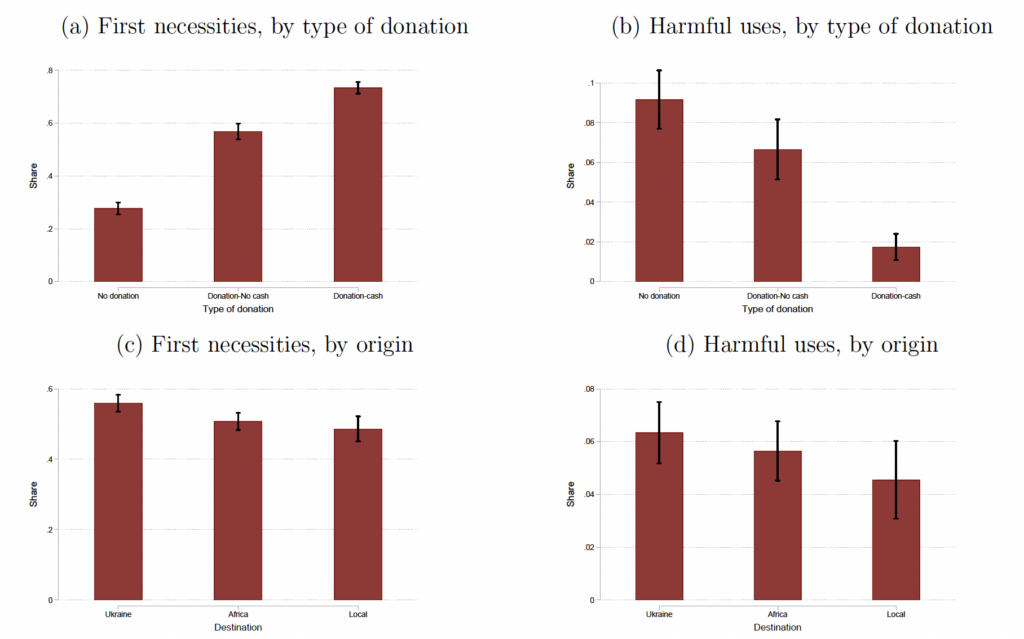
Notes: The figures plot the share of respondents who predicted that recipients of an in-cash donation would use it to purchase certain items by type of donation (panels a and b) and nationality of the beneficiary or origin (panels c and d). We defined an indicator equal to one if the words (the Italian equivalent of) "food," "clothing," "health," and "necessary" were present in a response, and zero otherwise to determine the reference to first necessities (panels a and c). For the category of harmful items (panels b and d), we included words such as "alcohol," "cigarettes," "drugs," "gambling," and "weapons." We stemmed the words and also considered synonyms of these terms. The Stata command to identify the presence of words in a document is ngram (Schonlau et al., 2017). Note that the scale of the y-axis is different in the various graphs.
Figure 3: Predicted probability of a topic in the motivation for donating, by whether respondents donated, donated only in kind, and also donated cash
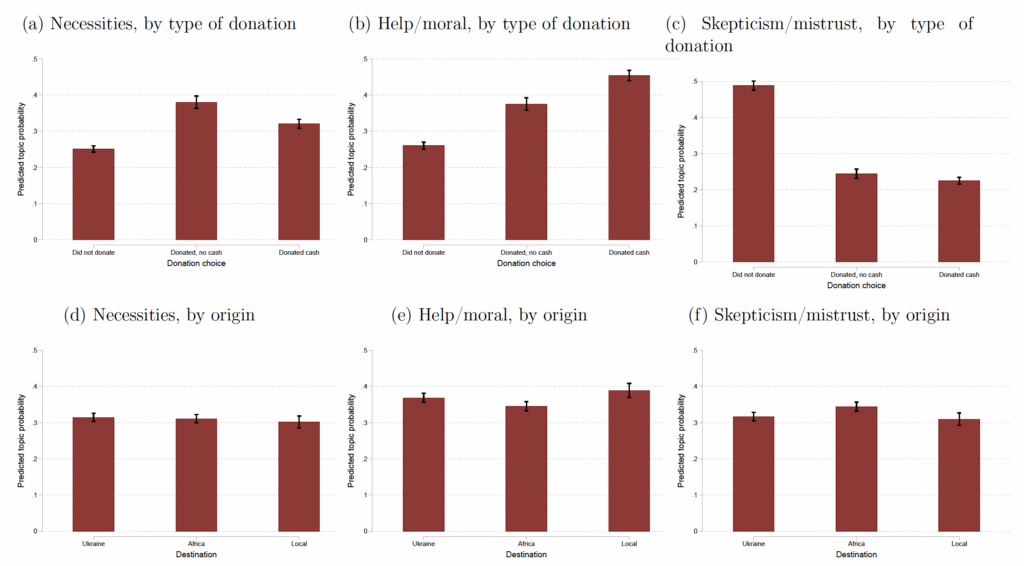
Notes: The graphs report the estimated probability that a topic appears in a comment reporting the reasons for a donation decision, by type of donation (panels a through c) and by nationality of the beneficiary or origin (panels d through f). We applied latent Dirichlet allocation (LDA) to the text of the answers. The Stata command that we used is ldagibbs (Shwartz, 2018). See table A.2 in the appendix for details about the three topics.
Similar to the predicted uses of cash donations, participants who committed some or all of their contribution to be in cash were more likely to bring arguments related to the primary needs of the recipients and to a moral duty to help them (figure 3, panels a and b). Conversely, those who did not donate at all, and to a lesser extent those who donated only in kind, are more likely to express skepticism about the uses of the funds than the respondents who donated some cash (panel c). Participants asked to donate to refugees from African countries were less likely to mention motives related to the moral imperative to help (panel e), and more likely to declare themselves skeptical and mistrustful (panel f). This pattern is consistent with the evidence that people tend to place lower trust in those with different characteristics from themselves (Buchan et al., 2006; DeBruine, 2002; Elfenbein et al., 2023).
Finally, we run additional tests to corroborate the hypothesis that cash donations imply more trust than in-kind donations. We exploit the question on generalized trust in others (Falk et al., 2023) that we asked in the survey. The answer ranges from 0 to 10, with a higher score indicating a greater trust in others. We test whether trust affects the probability of not donating at all, donating only in kind, and donating some cash. Table A.3 and Figure A.2 indicate that respondents who largely trust others are less likely to refuse to make a donation, more likely to share some of their endowment with the target group, and, in particular, more likely to do so by donating in cash. Trust increases both forms of donation (columns 2 and 3) but has a larger effect on cash donation. A one-unit increase in the trust score, from the average of 5.7 to 6.7, increases the probability of in-kind donation by 0.8 percentage points and cash donation by 1.7 percentage points. The difference between these two estimates is statistically significant.
These analyses suggest interpretations of our main econometric estimates that are consistent with our hypotheses. In particular, the form of a donation (cash vs. in-kind) is related to the expectation about the recipients’ ability to make "good" use of the money and that there is a weaker moral drive toward and higher mistrust of the most distant out-groups. This evidence also supports our hypothesis that respondents’ attitudes are influenced by perceived distance, with the more distant out-group suffering a higher level of prejudice due to lower trust. The evidence also supports our claim that donations in cash are a more reliable measure of attitudes because they are more effective at detecting subtler forms of prejudice than what is commonly used in the literature.
3.2.3 The null effect of information about EU-wide policy reforms
Next, we perform tests to investigate possible explanations for why the provision of information on EU-level refugee policy reforms did not have any effect on overall donations and on the percentage of donations in cash. In particular, we provide insights as to whether participants anticipated any effect of new EU policies on future flows and whether other possible channels through which policies may change people’s attitudes were present. To perform these tests, we estimate equation 1 using different outcome variables.
After the donation request, we asked participants their opinions about the implications of a stronger involvement of the EU in the domain of immigration and refugee policies for the influx of foreigners into Italy and the rest of Europe. Of the participants in the control condition, 35 percent expected that a higher EU involvement would not produce any changes in the number of immigrants into Italy or Europe; 22 percent expected more flows both into Europe and Italy; 17 percent expected more flows to Italy and fewer to Europe; 15 percent expected more to Europe and fewer to Italy; and 11 percent expected fewer flows to both Europe and Italy. Thus, a large majority of respondents (74 percent) believed a stronger EU involvement would lead to either no change or an increased inflow of immigrants into Italy.
Of these expected consequences, we are particularly interested in whether respondents believe that the EU-wide reforms would cause a reduction in immigrants reaching Italy and an increase in those going into other European countries; we, therefore, test whether this belief depends on receiving our information text on these policy changes.
The estimates in columns (1) and (2) of appendix table A.4 come from regressions where the outcome variable is equal to one if respondents expect an increase in the immigration flows to Europe and a decrease to Italy, and zero if they hold any other combination of these beliefs. The findings indicate that participants who received information on EU policies are four percentage points more likely to anticipate a decrease in immigrant influxes into Italy and an increase in other European countries. This increase represents a 22 percent rise relative to the baseline. Notably, this effect is primarily driven by participants who were assigned to donate to African refugees. In this case, the likelihood of expecting these changes increases by six percentage points. On the other hand, when the beneficiaries of the donations are from Ukraine, the increase in likelihood is only two percentage points (statistically insignificant). The difference between these effects is statistically significant. This evidence suggests that our survey respondents anticipated an effect of the policy information in a direction consistent with what one might expect from the reform. Italy is the first “port of entry” for people coming from the “Global South,” such as Africa, while it is not the first country of entry for flows from Ukraine. A stronger EU role in the asylum system and a more equal balance of effort in hosting asylum seekers imply that Italy would receive fewer asylum seekers from Africa than the status quo. Overall, these results show that respondents understood the information on EU-wide refugee policies, and the null effect on attitudes is not due to a lack of clarity and comprehension.
We conducted additional manipulation checks to understand if the information failed to activate some of the responses we hypothesized. For instance, the policy reform could influence attitudes by affecting trust in European institutions or influencing beliefs about normatively appropriate attitudes. These are the mechanisms that the existing literature has theorized as possible pathways between policies and attitudes. At the end of the survey, we asked participants whether they agreed or disagreed with the statement that the EU is treating Italy unfairly when it comes to managing migrants and refugees. We use this variable as a proxy for Italians’ trust in European institutions. We define an outcome variable equal to one if respondents believe the EU treats Italy unfairly and zero if they think that Italy is treated as fairly as all the other member states. Columns (3) and (4) of table A.4 provide evidence of a slightly lower agreement with this statement by those who received a treatment that included the EU policy information, but the estimates are not statistically significant.
Finally, to test whether the policy affected beliefs about peers’ attitudes toward migrants, we asked participants to predict the average donations by the other respondents and use this variable as a proxy of what the respondents considered socially appropriate. As columns (5) and (6) of table A.4 show, people generally expected others to donate substantially less than they actually did on average. The average predicted donation of others is 19 cents, whereas the average actual donation of the sample of respondents is 48 cents. Those assigned to donate to one of the two out-groups predicted lower average donations compared to those assigned to the control group, but there is no difference in predictions between respondents who received the EU policy information or and those who did not.
The above findings suggest that the respondents did pay attention to the new immigration policies highlighted in the survey. Conversely, the treatment failed to affect trust in the EU or the perceived social norms. We conclude that the effects of the information on EU refugee policies are quantitatively too small to impact attitudes meaningfully.
In summary, the evidence so far suggests that distance from the in-group affects attitudes and prejudice toward the out-group; conversely, the management of refugee flows does not affect these attitudes, even when reform would imply lower flows of a specific type of migrants.9Relatedly, Fouka and Tabellini (2022) report that changes in the volume of immigrants do little against prejudice when out-groups are relatively close to the natives in terms of distance.
3.2.4 Alternative explanations
One concern about interpreting our findings as resulting from distance-driven preferences is that they may depend on the differing salience of the wars that forced Ukrainian and African refugees to flee their countries. However, several reasons favor the distance over the salience hypothesis. First, we conducted our survey during a period when the war between Russia and Ukraine was less prominent in the media than in the initial phase, whereas news of refugee arrivals via the Mediterranean Sea is extensively covered by the Italian media on a regular basis (figureA.3 in the appendix).10The figure shows the Google Trends results from querying the Italian-equivalent expressions of "Ukrainian refugees" and "disembarkation," the word used to signify the arrivals of immigrants from the Mediterranean Sea on Italian coasts, in 2022 and 2023, with the indication of relevant dates: the beginning of the Russian military invasion of Ukraine, the peak in refugee arrivals via the Mediterranean in the fall of 2022, and the period in which we conducted our survey. This suggests that the media attention and exposure to these conflicts were not a major influencing factor in the donation choices of the participants. Second, although participants assigned to donating to Ukrainian refugees mentioned the word "war" in their open-ended answers more often than those who were asked to donate to African refugees or Italians, the use of this word was overall rare (4.7 percent of comments in the Ukraine condition, 1.2 percent in the Africa condition, and 0.1 percent in the local condition). Moreover, there was no difference in the frequency of use of the word between those who donated and those who chose not to donate, suggesting that even if the war in Ukraine was somewhat more salient, it was not necessarily driving the expressed support for refugees from different origins. Finally, if the salience of war were to influence donation choices significantly, we would expect to observe a similar pattern across various types of donations. However, our findings suggest otherwise. These considerations reinforce our claim that distance-based preferences drive the observed outcomes.
A further potential explanation of the differing attitudes toward the two out-groups that we consider is that survey participants may hold different beliefs about the characteristics of refugees from different parts of the world. For example, they may consider one group as including more vulnerable categories, such as women and children, than the other. As such, the propensity to donate may not depend on ethnic, cultural, or racial distance, but would rather be based on the perceived level of need. Although we do not have direct information to address this concern definitively, there are, again, features of our evidence that allay it. First, if the willingness to donate was mostly need-based, then we should either observe the same average donation levels for both out-groups and the same cash vs. in-kind average preferred composition, or find the same difference between out-group origin in both variables. However, the expected demographic composition of a group of refugees may also affect the participant’s trust in how "properly" that group may use direct cash; and this could lead, for example, to being more reluctant to donate cash to one group than to the other. Figure 2 above, however, shows that the expectation of harmful uses does not vary by the nationality of recipients (panel d).11Respondents mention more often the purchase of alcohol or weapons when the recipients are Ukrainian refugees, and drugs for African recipients.
Finally, the divergent attitudes toward the two out-groups might stem from the varying expected length of the refugees’ stay abroad, with the perception that refugees from Africa will have a longer stay in the host country due to Africa’s ongoing strong push factors. However, there is no reason for this mechanism to impact donation levels and cash vs. in-kind composition differently, as we have observed. Overall, we do not detect substantial evidence that participants might have made their donation choices based on different beliefs about the demographics or needs or stay duration of the recipients in the various groups.
3.2.5 Heterogeneity and the sources of out-group prejudice
We preregistered three analyses of heterogeneous effects that we considered of primary relevance to understanding the underlying causes of prejudice toward different out-groups: differences in donation behavior by (1) educational attainment, (2) political orientation, and (3) self-reported European identity.
First, individuals with higher levels of education often have greater exposure to diverse perspectives and knowledge about global issues. This may foster more empathetic attitudes. In contrast, less formal education may exacerbate stereotypes and negative perceptions, leading to prejudice against refugees. Additionally, highly educated workers may feel less threatened by the competition of immigrants on the labor market than less-educated individuals, and may even perceive immigrants and refugees as an opportunity for the local economy. Figure A.4 in the appendix shows that, on average, respondents with at least a college degree have a more positive view of the impact that immigrants may have on the local economy and culture than respondents with less formal education.
Second, research shows that people with left-leaning political preferences hold more universalistic views, while right-leaning individuals tend to display more parochial attitudes (Enke et al., 2023). These differing ideological stances may manifest not only in lower overall donations by more conservative participants, but also greater in-group favoritism by these respondents compared to the more liberal ones (Enke et al., 2023; Pizziol et al., 2023). Moreover, if social distance is a determinant of the lower support for out-group members, then parochialism may lead to discrimination among out-groups or a ranking that further penalizes individuals perceived as more different—in our context, the refugees from African countries as opposed to the ones from Ukraine.
Lastly, people who strongly identify with Europe may feel a sense of commonality and responsibility toward other European citizens, leading to more positive attitudes and support for policies promoting solidarity and integration, but potentially with more favor toward fellow Europeans (Ukrainians in our case). Conversely, those who feel a stronger attachment to their national or local domain than to supranational entities may view refugees as a potential threat to their cultural and national cohesion and, therefore, may show more negative attitudes and potential prejudice.
To show how education, European identity, and political leanings influence donations (overall and in cash), we begin by presenting, in columns (1) and (2) of table 3, the estimates from regressions similar to those from columns (2) and (4) of table 2, but including controls for those additional variables.
On average, individuals with a college education did not commit higher donation amounts than those with lower educational attainment, nor did they allocate a different share of their donation to cash. Conversely, the donation amount varied with the participants’ political leanings and their identification with the EU, which likely reflects deeper, more entrenched beliefs. Consistent with evidence from recent studies (e.g., Kerschbamer and Müller (2020); Cagé and Huang (2023)), participants with more conservative political leanings tended to donate less, with a statistically significant reduction of 1.5 cents for each point of the rightwing score. The percentage of cash donations, in contrast, did not vary with different political views. People expressing a strong EU identity tended to donate significantly more (8.7 additional cents) than those with lower identification with Europe, but they did not choose a different percentage of cash.
We then augment our regression model with interactions between the Africa and Ukraine indicators (combining the conditions with and without EU policy information) and, in turn, the variable measuring our hypothesized source of heterogeneity.
In column 3, the estimated coefficients indicate that college education attenuates out-group bias as measured by the donation amount.
Figure 4: Donations by origin and educational attainment
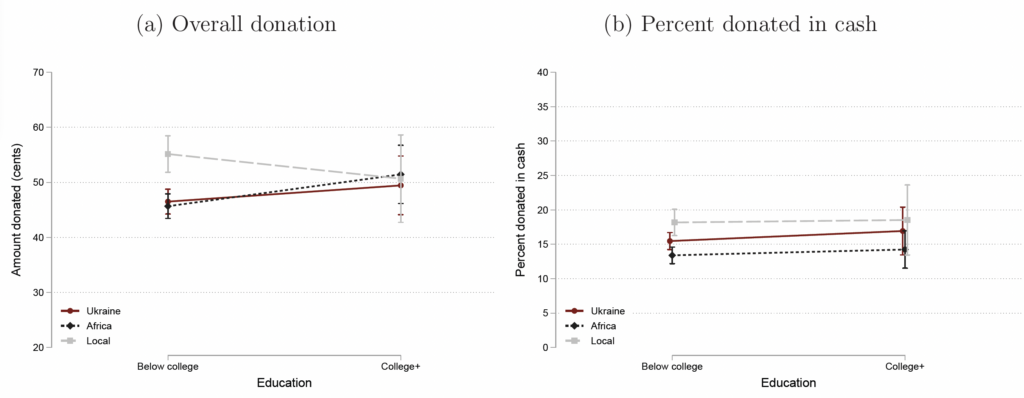
Notes: The figures plot the best residualized prediction of donation amount (panel a) and percent donated in cash (panel b) by educational attainment (below college vs. college or beyond). The plotted relationships derive from regressions of donations (total and percent cash) on an indicator for having attained at least a college degree, controlling for binary indicators of (high or low) EU identity, (high or low) concerns about immigration, gender, political leaning as expressed by a 10-point (in 0.1 increments) “right-wing” index, and age (four categories). The vertical capped lines represent confidence intervals with robust standard errors.
Education, however, does not moderate the differences in the percentage of donations in cash due to origin (column 4). Both college-educated and non-college-educated respondents display a similar negative bias toward the most distant group of African refugees when measured by donation in cash.
Figure 4 provides visual evidence of the estimated differences in treatment effects by educational attainment. Both college-educated and non-college-educated respondents show a pattern of giving a higher percentage of cash to locals, followed by Ukrainians, and finally Africans, although the precision of these estimated differences is lower for the college-educated (less numerous) group.
In columns 5 and 6 and figure 5, we turn to interactions of the Africa and Ukraine treatments and the respondents’ political orientation, again measured by the right-wing score.
Figure 5: Donations by origin and political leaning
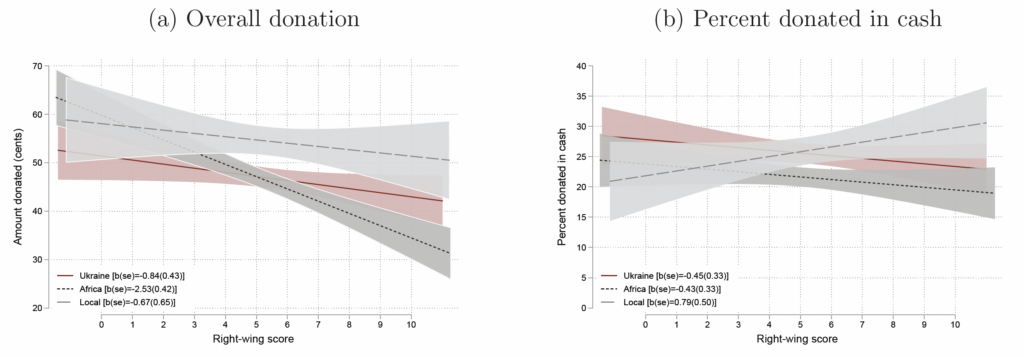
Notes: The figures plot the best residualized linear fit between total donation (panel a) and percent of donation in cash (panel b), and political orientation, by origin. The plotted relationships derive from regressions of donations (total and percent cash) on political leaning as expressed by a 10-point (in 0.1 increments) rightwing index, controlling for binary indicators of (high or low) EU identity, (high or low) concerns about immigration, gender, educational attainment (below college vs. college or beyond) and age (four categories). The shaded areas represent confidence intervals with robust standard errors, and the "b(se)" values in square brackets in the legend represent the coefficient (robust standard error) estimates on the right-wing index in each of the three separate regressions by origin.
The estimates indicate larger penalties to African beneficiaries from individuals with more right-leaning political views. Similarly, the negative relationship between right-wing orientation and overall donation is steeper and more significant when the beneficiaries are African refugees. As one moves from the left to the right side of the political spectrum, the average amount donated to the three groups of beneficiaries goes from being statistically indistinguishable to a stark ranking whereby respondents donate most to local beneficiaries, then to Ukrainian refugees, and least of all to African refugees. The graph in panel (b) shows the percent of a donation to be made in cash as the outcome of interest. Again, differences emerge, especially for right-leaning participants. In this case, the relationship between the percentage donated in cash and the right-wing index is positive when the beneficiaries are Italian nationals. Conversely, the lines are negatively sloped when the beneficiaries are foreigners. The ranking of preferences emerges only for conservative individuals, with stronger preferences for the least distant group and weaker for the most distant one. The evidence in appendix figure A.5 suggests that, at least in part, the greater heterogeneity in attitudes toward more distant out-groups that people with different political beliefs show may depend on the more extreme differences in the expectation of how members of different out-groups may use the donated money. For African refugees, there is greater variance in beliefs by recipients with different political views about the use of cash to buy harmful goods and first necessities than for Ukrainian and local beneficiaries. Lastly, in columns 7 and 8 of table 3, we explore heterogeneity based on the respondents’ strength of identification as European citizens. We do not observe any differential impact of the Africa and Ukraine treatments across different levels of this variable, either on overall donation or donation in cash (see also figure 6).12The results that we presented in this section are all robust to adjustments for multiple hypotheses testing.
Figure 6: Donations by origin and strength of European identity
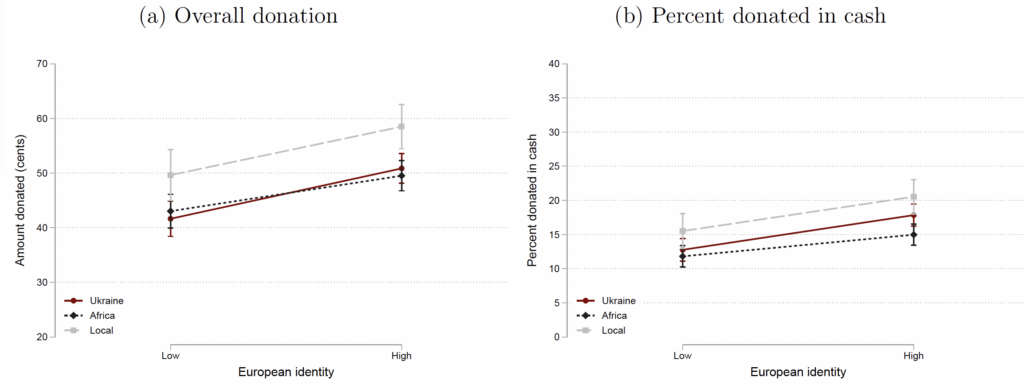
Notes: The figures plot the best residualized prediction of donation amount (panel a) and percent donated in cash (panel b) by EU identity (high or low). The plotted relationships derive from regressions of donations (total and percent cash) on EU identity (high or low), an indicator for having attained at least a college degree, a binary indicator of (high or low) concerns about immigration, gender, political leaning as expressed by a 10-point (in 0.1 increments) “right-wing” index, and age (four categories). The vertical capped lines represent confidence intervals with robust standard errors.
4 Discussion and conclusions
Consistent with previous research on sentiments toward immigrants, we find evidence that attitudes toward a special category of these out-group members, namely refugees from war-ridden areas, also present out-group biases. By introducing a novel measure of attitudes that detects subtler forms of prejudice and is less likely to suffer from social desirability bias than standard measures (i.e., the share of donations made in cash vs. in kind), we find that individuals respond differently to different out-groups. They display, in particular, a hierarchical approach, with the bias increasing with the distance between in-group members and the out-groups. A standard measure of attitudes more prone to social desirability concerns or experimenter demand effects (i.e., the overall propensity to donate to out-group members in a dictator game) fails to identify this ranking based on distance. Furthermore, the motivations that respondents associate with making fewer cash donations to African refugees reveal a higher level of prejudice, suggesting a belief that those refugees may not use the money appropriately. Evidence from textual analyses of open-answer questions suggests that this prejudice reflects a lower trust that people display toward persons from distant out-groups. Our novel measure of attitudes, combined with text analysis, thus helps detect underlying prejudice and clarify its origins.
Reforming the asylum regime by assigning the EU a more direct and robust role to ensure a more balanced management of the flow of refugees does not influence attitudes. Although public opinion tends to influence policies, changes in attitudes through policy reforms are more difficult to obtain.
The root of the out-group bias, particularly in the hierarchy of out-groups in terms of attitudes toward them, relates instead to natives’ characteristics, notably their political orientation. Respondents who most display bias (i.e., those with right-leaning political views) have prejudice about how different groups may use the cash support that they receive and also reveal mistrust about the effective delivery of these resources.
This paper makes four contributions. First, we study out-group biases with specific reference to refugees. This group represents a critical category of migrants due to the increasingly frequent global crises and the unique sociopolitical dynamics surrounding their reception. Although one may expect a more positive sensitivity toward refugees than immigrants in general because of the motivations of their move, we find that bias still exists. Second, we introduce a new measure of attitudes—the share of cash vs. in-kind donations—and demonstrate that this measure helps reveal more subtle forms of prejudice. Third, we find that out-group bias increases with the perceived distance between the in-group and the out-group, and we document that the bias is related to prejudice about how individuals from distant out-groups might use cash donations. Fourth, we consider the effect of policies at a supranational level, focusing on the European Union’s asylum regime, to assess whether EU-level policies can shape the social climate within member states and affect attitudes toward refugees. We find no effect of an enhanced EU role in the management of refugee inflows on attitudes.
Our results suggest that interventions targeting deep-seated prejudice directly may be more effective in shaping attitudes toward refugees (or migrants in general) than reforms focused on the regulatory aspects of migration. At the same time, because of the deep roots of these biases, attempts to enhance inclusion may face significant obstacles. The association between political orientation and attitudes toward refugees, for example, creates a potential avenue for manipulation of public opinion. Politicians may be tempted to exploit ideology-driven impulses that drive these attitudes for electoral gain, leading to further polarization of the debate around refugees and immigration, potentially amplifying prejudices and undermining efforts to foster inclusion and acceptance. Similarly, the link between education and attitudes toward refugees presents its own difficulties. Enhancing the average educational attainment of a population to promote a more open-minded and tolerant society requires significant time and resources. These efforts would need to prioritize exposure to diversity and ideally include improved job opportunities to alleviate feelings of threat and insecurity. Policymakers need to navigate these challenges carefully, ensuring that efforts to alter attitudes do not inadvertently exacerbate existing prejudices or deepen societal divisions.
Appendix
A Additional Tables and Figures
Figure A.1: Balance test
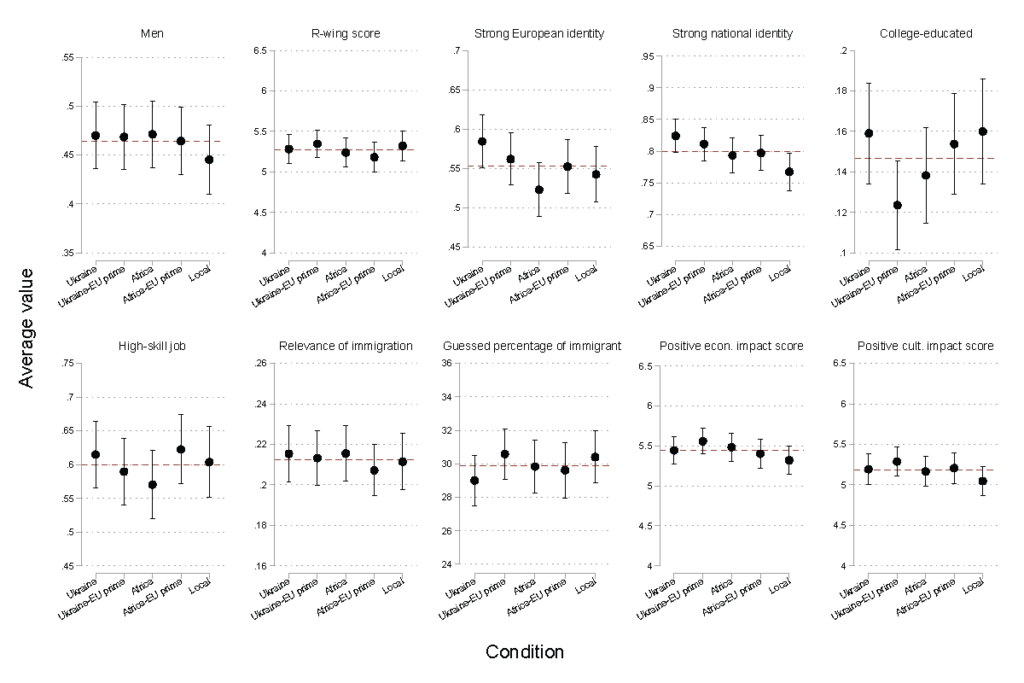
Notes: The figures provide summary information and balance tests for the socio-demographic characteristics of respondents.
Figure A.2: Donation behavior and trust in others
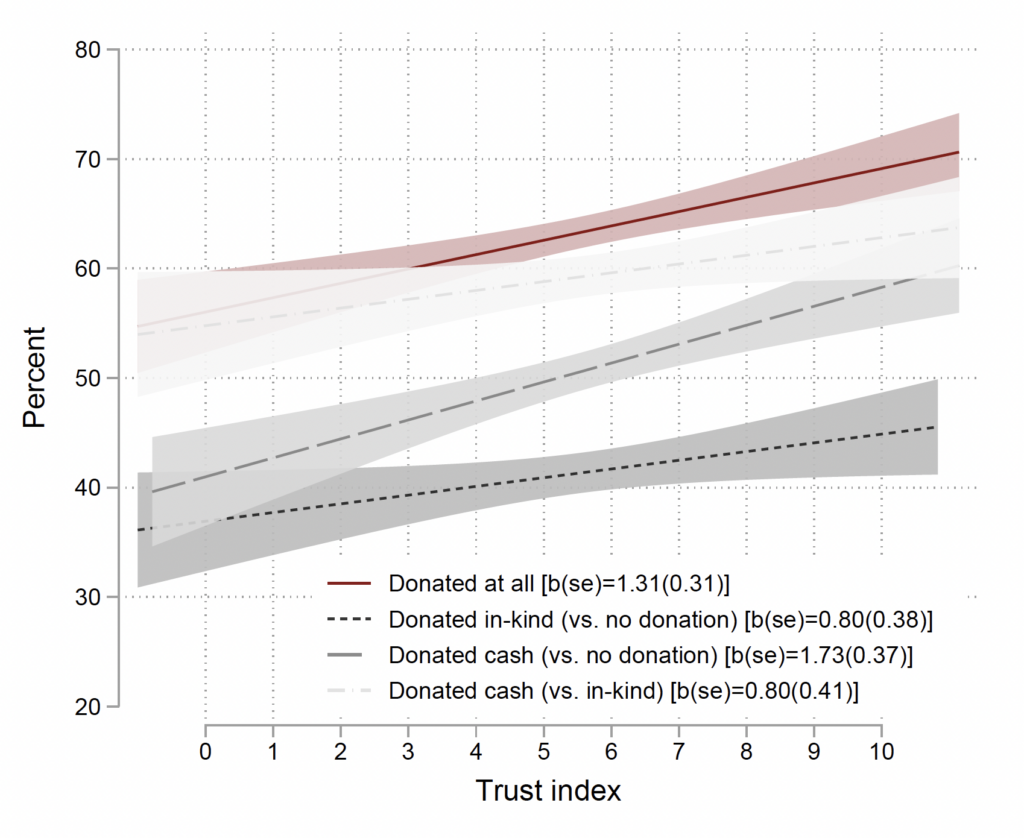
Notes: The figure plots the best residualized linear prediction of different indicators of donation behavior, as reported in the legend, as a function of respondents’ trust in others. The measure of trust in others derives from the score, from 0 to 10 in 0.1 increments, that the participants assigned to their agreement with the sentence "Usually people act with their best intentions." The regressions from which the plotted lines derive also controlled for the recipients’ origins, EU identity (high or low), an indicator for having attained at least a college degree, a binary indicator of (high or low) concerns about immigration, gender, political leaning as expressed by a 10-point (in 0.1 increments) "right-wing" index, and age (four categories). The shaded areas represent 95 percent confidence intervals with robust standard errors.
Figure A.3: Salience of Ukrainian refugee crises and the arrival of immigrants via the Mediterranean Sea
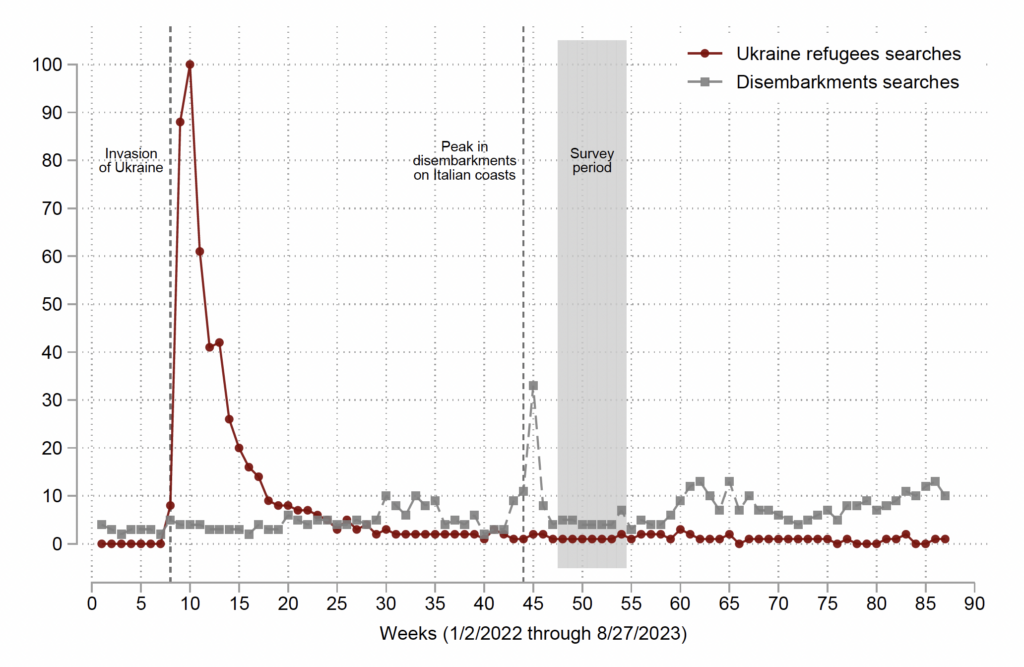
Notes: The graph shows the Google Trends results from querying the Italian-equivalent expressions of "Ukrainian refuges" and "Disembarks," the word used to signify the arrivals of immigrants via the Mediterranean Sea on Italian coasts, in 2022 and 2023, with indication of relevant dates: the beginning of the Russian military invasion of Ukraine, the peak in immigrant arrivals from the Mediterranean in the fall of 2022, and the period in which we conducted our survey.
Figure A.4: Perception of impacts of immigration by educational attainment
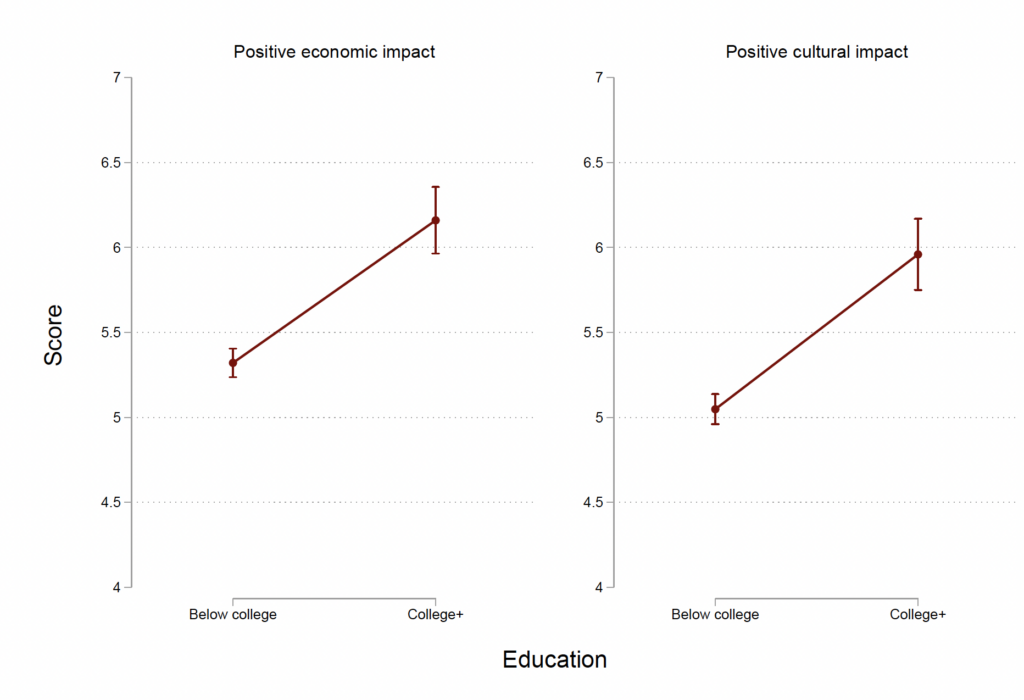
Notes: The figure reports the average scores of agreement with the sentences "Immigrants have a positive economic impact" and "Immigrants have a positive cultural impact," by whether respondents held at least a college degree or not. The scores ranged from 0 to 10 in 0.1 increments. The vertical capped lines represent 95 percent confidence intervals.
Figure A.5: Share of respondents indicating different categories of items refugees would use with a cash donation, by origin
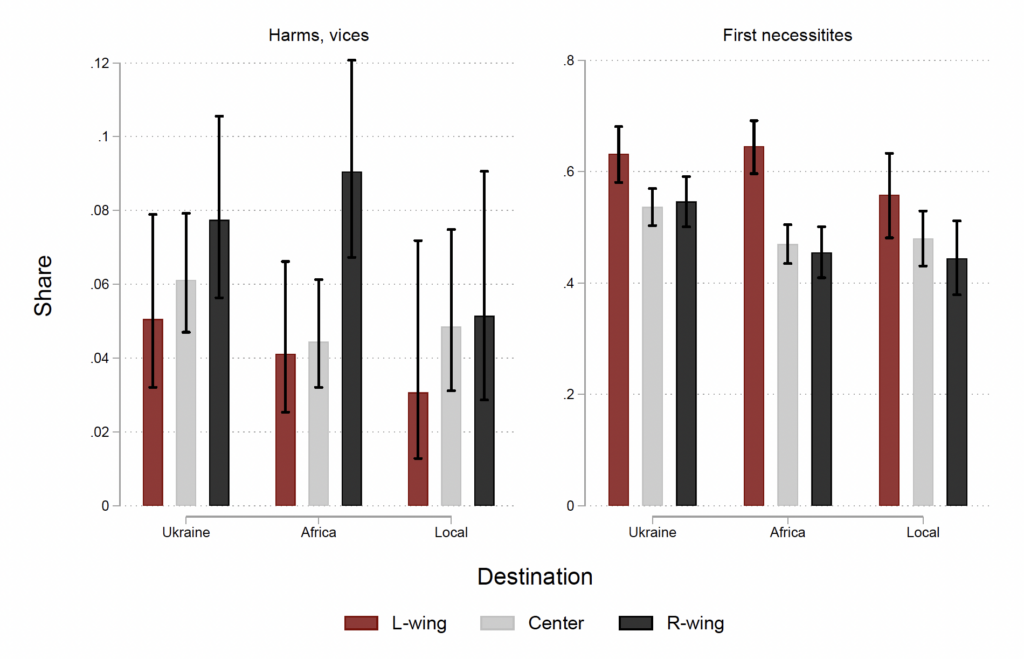
Notes: The figures plot the share of respondents who indicated that the recipient of an in-cash donation would use it to purchase certain categories of items, by recipient’s origin and political orientation of the participants. For the category of harmful items, we included words such as "alcohol," "cigarettes," "drugs," "gambling," and "weapons."We defined an indicator that included (the Italian equivalent of) "food," "clothing," "health," and "necessary" to determine the reference to first necessities. We also considered synonyms of these terms and counted the occurrence of the stemmed version of each word. The Stata command to identify the presence of words in a document is ngram (Schonlau et al., 2017). Note that the scale of the y-axis is different in the two graphs. The vertical capped lines represent 95 percent confidence intervals.
References
Abdelaaty, L. E. (2021). Discrimination and delegation: Explaining state responses to refugees. Oxford University Press.
Alesina, A., A. Miano, and S. Stantcheva (2023). Immigration and redistribution. The Review of Economic Studies 90 (1), 1–39.
Ambuehl, S., B. D. Bernheim, and A. Ockenfels (2021). What motivates paternalism? an experimental study. American Economic Review 111 (3), 787–830.
Baker, A. (2015). Race, paternalism, and foreign aid: Evidence from u.s. public opinion. American Political Science Review 109 (1), 93–109.
Bansak, K., J. Hainmueller, and D. Hangartner (2016). How economic, humanitarian, and religious concerns shape European attitudes toward asylum seekers. Science 354 (6309), 217–222.
Bansak, K., J. Hainmueller, and D. Hangartner (2017). Europeans support a proportional allocation of asylum seekers. Nature Human Behaviour 1 (7), 0133.
Bansak, K., J. Hainmueller, and D. Hangartner (2023). Europeans’ support for refugees of varying background is stable over time. Nature 620 (7975), 849–854.
Benjamini, Y., A. M. Krieger, and D. Yekutieli (2006). Adaptive linear step-up procedures that control the false discovery rate. Biometrika 93 (3), 491–507.
Browning, E. K. (1981). A theory of paternalistic in-kind transfers. Economic Inquiry 19 (4), 579–597.
Buchan, N. R., E. J. Johnson, and R. T. Croson (2006). Let’s get personal: An international examination of the influence of communication, culture, and social distance on other regarding preferences. Journal of Economic Behavior & Organization 60 (3), 373–398.
Burstein, P. (2003). The impact of public opinion on public policy: A review and an agenda. Political Research Quarterly 56 (1), 29–40.
Bursztyn, L., T. Chaney, T. A. Hassan, and A. Rao (2024). The immigrant next door. American Economic Review.
Bursztyn, L., G. Egorov, and S. Fiorin (2020). From extreme to mainstream: The erosion of social norms. American Economic Review 110 (11), 3522–3548.
Cagé, M, H. J. and Y. Huang (2023). The far-right donation gap. Cepr discussion paper no. 18356.
Choi, D. D., M. Poertner, and N. Sambanis (2022). Native bias: Overcoming discrimination against immigrants. Princeton University Press.
Cunha, J. M. (2014). Testing paternalism: Cash versus in-kind transfers. American Economic Journal: Applied Economics 6 (2), 195–230.
Currie, J. and F. Gahvari (2008). Transfers in cash and in-kind: Theory meets the data. Journal of Economic Literature 46 (2), 333–383.
DeBruine, L. M. (2002). Facial resemblance enhances trust. Proceedings of the Royal Society of London. Series B: Biological Sciences 269 (1498), 1307–1312.
Dennison, J. and A. Kustov (2023). The reverse backlash: How the success of populist radical right parties relates to more positive immigration attitudes. Forthcoming in Public Opinion Quarterly.
Dylong, P., P. Setzepfand, and S. Uebelmesser (2023). Priming attitudes toward immigrants: Implications for migration research and survey design. Cesifo working paper 10306.
Elfenbein, D. W., R. Fisman, and B. McManus (2023). The impact of socioeconomic and cultural differences on online trade. Management Science.
Enke, B., R. Fisman, L. M. Freitas, and S. Sun (2023). Universalism and political representation: Evidence from the field. Working paper 31265, National Bureau of Economic Research.
Enke, B., R. Rodriguez-Padilla, and F. Zimmermann (2022). Moral universalism: Measurement and economic relevance. Management Science 68 (5), 3590–3603.
Evans, D. and A. Popova (2014). Do the poor waste transfers on booze and cigarettes? no. Technical report, World Bank.
Evans, D. K. and A. Popova (2017). Cash transfers and temptation goods. Economic Development and Cultural Change 65 (2), 189–221.
Falk, A., A. Becker, T. Dohmen, D. Huffman, and U. Sunde (2023). The preference survey module: A validated instrument for measuring risk, time, and social preferences. Management Science 69 (4), 1935–1950.
Flores, R. D. (2017). Do anti-immigrant laws shape public sentiment? A study of Arizona’s SB 1070 using Twitter data. American Journal of Sociology 123 (2), 333–384.
Fong, C. M. and E. F. P. Luttmer (2009). What determines giving to hurricane katrina victims? experimental evidence on racial group loyalty. American Economic Journal: Applied Economics 1 (2), 64–87.
Fouka, V., S. Mazumder, and M. Tabellini (2022). From immigrants to Americans: Race and assimilation during the great migration. The Review of Economic Studies 89 (2), 811–842.
Fouka, V. and M. Tabellini (2022). Changing in-group boundaries: The effect of immigration on race relations in the United States. American Political Science Review 116 (3), 968–984.
Greenwald, A. G., D. E. McGhee, and J. L. Schwartz (1998). Measuring individual differences in implicit cognition: The implicit association test. Journal of Personality and Social Psychology 74 (6), 1464.
Grigorieff, A., C. Roth, and D. Ubfal (2020). Does information change attitudes toward immigrants? Demography 57 (3), 1117–1143.
Hagerty, S. F. and K. Barasz (2020). Inequality in socially permissible consumption. Proceedings of the National Academy of Sciences 117 (25), 14084–14093.
Hainmueller, J. and D. J. Hopkins (2015). The hidden American immigration consensus: A conjoint analysis of attitudes toward immigrants. American Journal of Political Science 59 (3), 529–548.
Halapuu, V., T. Paas, T. Tammaru, and A. Schütz (2013). Is institutional trust related to pro-immigrant attitudes? a pan-European evidence. Eurasian Geography and Economics 54 (5- 6), 572–593.
Hangartner, D., E. Dinas, M. Marbach, K. Matakos, and D. Xefteris (2019). Does exposure to the refugee crisis make natives more hostile? American Political Science Review 113 (2), 442–455.
Kerschbamer, R. and D. Müller (2020). Social preferences and political attitudes: An online experiment on a large heterogeneous sample. Journal of Public Economics 182, 104076.
Kustov, A. (2021). Borders of compassion: Immigration preferences and parochial altruism. Comparative Political Studies 54 (3-4), 445–481.
Kustov, A. (2023). Testing the backlash argument: Voter responses to (pro-)immigration reforms. Journal of European Public Policy 30 (6), 1183–1203.
La Barbera, F., P. Cariota Ferrara, and M. Boza (2014). Where are we coming from versus who we will become: The effect of priming different contents of European identity on cooperation. International Journal of Psychology 49 (6), 480–487.
Liscow, Z. and A. Pershing (2022). Why is so much redistribution in-kind and not in cash? evidence from a survey experiment. National Tax Journal 75 (2), 313–354.
MacKay, D. (2019). Basic income, cash transfers, and welfare state paternalism. Journal of Political Philosophy 27 (4), 422–447.
Moore, C. (2009). Nicaragua’s red de protección social: An exemplary but short-lived conditional cash transfer programme. Technical report, International Policy Centre for Inclusive Growth.
Overseas Development Institute (2022). Fleeing ukraine and the inequality of Africa-Europe relations. https://odi.org/en/insights/fleeing-ukraine-and-the-inequality-of-africa-europe-relations. Accessed: 2024-01-21.
Pizziol, V., X. Demaj, R. Di Paolo, and V. Capraro (2023). Political ideology and generosity around the globe. Proceedings of the National Academy of Sciences 120 (15), e2219676120.
Raux, R. (2023). Signaling universalism. Working paper, Harvard University.
Schonlau, M., N. Guenther, and I. Sucholutsky (2017). Text mining with n-gram variables. The Stata Journal 17 (4), 866–881.
Shayo, M. (2009). A model of social identity with an application to political economy: Nation, class, and redistribution. American Political Science Review 103 (2), 147–174.
Shayo, M. (2020). Social identity and economic policy. Annual Review of Economics 12, 355–389.
Sherif, M. (1961). Intergroup conflict and cooperation: The Robbers Cave experiment, Volume 10. University Book Exchange Norman, OK.
Shwartz, C. (2018). Ldagibbs: A command for topic modeling in stata using latent dirichlet allocation. The Stata Journal 18 (1), 101–117.
Sjöberg, O. (2004). The role of family policy institutions in explaining gender-role attitudes: A comparative multilevel analysis of thirteen industrialized countries. Journal of European Social Policy 14 (2), 107–123.
Solodoch, O. (2021). Regaining control? The political impact of policy responses to refugee crises. International Organization 75 (3), 735–768.
Tabellini, M. (2020). Gifts of the immigrants, woes of the natives: Lessons from the age of mass migration. The Review of Economic Studies 87 (1), 454–486.
Tajfel, H., J. C. Turner, W. G. Austin, and S. Worchel (1979). An integrative theory of intergroup conflict. Organizational Identity: A Reader 56 (65), 9780203505984–16.
Taylor, P. (2022). Do poor people waste money more than anyone else? Technical report, https://paulitaylor.com/2022/07/17/do-poor-people-waste-money-more-than-anyone-else/.
Vrânceanu, A. and R. Lachat (2021). Do parties influence public opinion on immigration? Evidence from Europe. Journal of Elections, Public Opinion, and Parties 31 (1), 1–21.
Waytz, A., R. Iyer, L. Young, J. Haidt, and J. Graham (2019). Ideological differences in the expanse of the moral circle. Nature Communications 10 (1), 1–12.




